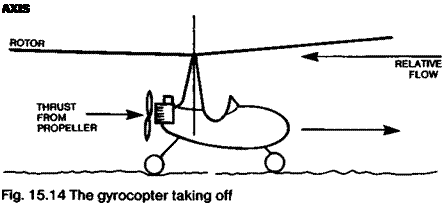GYROCOPTERS AND AUTOGYROS
 |
The autorotation capability of a rotor enabled gyrocopters (autogyros) to fly successfully long before helicopters were developed. Forward motive power is supplied by an ordinary propeller, rigged either as a ‘tractor’ or ‘pusher*, but the lift comes from a freely spinning rotor which may be tilted to provide control, and has the usual hinged and flapping blade system. Take-off may be accomplished by running along the ground until the rotor is turning sufficiently fast to give the required lift The take-off distance can be shortened if the rotor is given a preliminary spin by hand before starting the ground run.
Juan de Cierva’s autogyros of pre-1939 times were capable of near vertical take-off because a drive shaft was connected to the rotor with a clutch from the main engine. With blades set in zero collective pitch the rotor was spun up to high speed and allowed then to turn freely while the drive was declutched, all the engine power turning the propeller. The rotor was then set to positive pitch and the craft would leap into the air, quickly accelerating horizontally under the propeller thrust Landings were by gliding descent and the ground run was very brief.
Model autogyros are occasionally seen and all the same principles apply to them as to the full-sized aircraft. Although there is no strong torque reaction, as there is with a helicopter, the autogyro rotor does tend to turn the fuselage because of the friction of the main bearings, which cannot be entirely removed. It is therefore necessary to provide some aerodynamic means of aligning the fuselage with the airflow and this requires at least a vertical fin to give a weathercocking action. A rudder is also useful. Other wing and tail-like surfaces may also be used to supplement the rotor lift and control the attitude in flight.












